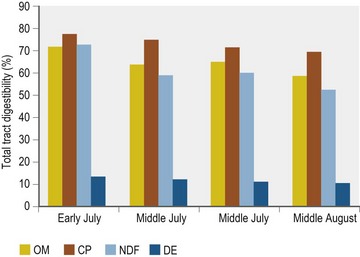17 Feedstuffs for horses
Introduction
Practical horse feeding differs between countries, mainly due to the availability of feedstuffs and the existence of long held beliefs over what can/should or cannot/should not be fed, i.e. traditions. Whilst a large number of feedstuffs are available and can be used in the formulation of diets for horses (Axelsson 1943, Nehra et al 2005, Olsson & Ruudvere 1955, Sauvant et al 2004) because of “tradition”, most horse owners only use a limited number of feedstuffs and are reluctant to try alternatives. However, in compounded concentrate feeds (complementary feeds) the range of feedstuffs used is larger and there is a great interest in the feed industry to find alternatives to the traditional feed ingredients.
There are different ways to classify feedstuffs depending on the criteria used to formulate diets (Axelsson 1943). The international feed identification system classifies feedstuffs into the following eight categories (Kellems & Church 2010):
Roughage
Roughage should always be the foundation of a horse’s diet. Any additional grains or protein/vitamin/mineral supplements should be used only to supply additional energy and/or essential nutrients not supplied by the roughage. Through the well-developed symbiosis with the hindgut microbiota, and its production of energy yielding substrates in the form of volatile or short-chain fatty acids (SCFA), it should be possible to provide the energy needs of most horses with a forage-only diet (NRC 2007). However, the most common feeding practise for performance horses world-wide today is to supplement the roughage part of the diet (hay, haylage, silage, straw) with a cereal-based concentrate (complementary) feed (Gallagher et al 1992, Lindner & Gansen 1995, Richards et al 2006). Concentrate is included in diets for athletic horses in order to increase the energy density and thereby make it possible to meet increased energy requirements. Roughage can be grazed or fed post harvesting in the fresh or more commonly a preserved/conserved form. Many roughage sources may potentially be used in horse feeding (Kellems & Church 2010), but the most commonly used roughages for stall-fed horses are various forages (hay, silage, haylage) of different botanical composition (grasses, legumes, herbs) and straw (NRC 2007, Nehra et al 2005).
Grazed forage forms the basis of diets for wild equids and can constitute the entire diet for domesticated horses (NRC 2007). In northern Europe, pasture generally cannot be provided all year round due to the cold climate and snow cover. In southern Europe, as well as in many other parts of the world, low precipitation and/or periods of drought may be reasons for limited forage supply from pasture. Therefore, forage has to be harvested and preserved either by drying or by ensiling to provide a year-round source of roughage.
Nutritional properties
Forages are composed of cell contents (protein, fat, soluble carbohydrates) and cell walls (cellulose, hemicellulose, lignin); the relative proportions of which vary according to the forage source and maturity at the time of harvest. The cell content is highly digestible (80–100%; Fonnesbeck 1968, 1969), while the true digestibility of the cell wall is more limited (40–50%; Fonnesbeck 1968, 1969). Thus, the energy and nutritive value of forages can vary considerably (Ragnarsson & Lindberg 2008, 2010) and will to a large extent be determined by fiber content and fiber quality (Van Soest 1994). This implies that the forage used in horse feeding should be carefully selected in order to provide appropriate levels of energy and nutrients, and not just the fiber necessary to support hindgut function.
The stage of maturity will have a profound effect on the energy and nutrient content of the forage and on the ability of the horse to consume offered quantities (NRC 2007). By selecting high-quality forage (high energy content) the required proportions of forage and concentrate can be markedly affected, and made more favorable with regards to voluntary feed intake and digestive function (Willard et al 1977, Julliand et al 2001). The daily intake of starch and dietary fiber will be markedly affected by the cereal source used in the diet (Table 17-1), as will the digestion of the cereal carbohydrate within the small intestine (Kienzle 1994) and the quantities of rapidly fermentable carbohydrates reaching the hindgut (Julliand et al 2006). This in turn will affect the ratio of fermentable starch to dietary fiber in the digesta reaching the hindgut, and thus the composition and activity of hindgut microbiota.
Table 17-1 Chemical Composition (g/kg Dry Matter), Proportion of Lysine (% of Crude Protein), and Content of Linoleic and Linolenic Acid (g/kg Dry Matter) and Energy (MJ/kg Dry Matter) in Cereals and Cereal by-Productsa,b
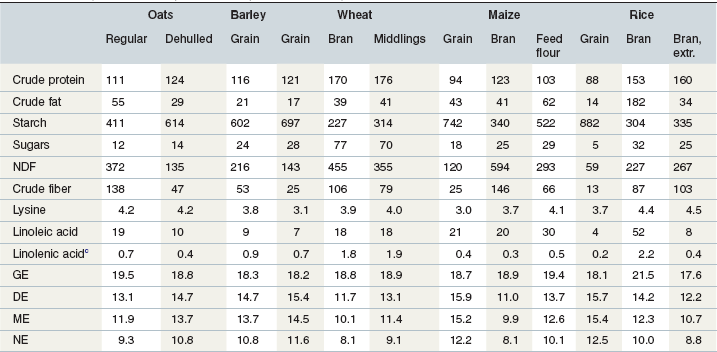
a Data from Sauvant et al (2004).
b GE = gross energy, DE = digestible energy, ME = metabolizable energy, NE = net energy.
Country of origin may also influence the nutritive value of a particular forage type. It was recently shown for example that forage grown in Iceland (timothy and mixed grass forage) and fed to Icelandic horses had high digestibility values for all dietary components, including the fiber fraction (Ragnarsson & Lindberg 2008, 2010). Moreover, although the energy content in the forages declined with advancing maturity, late cuttings maintained high energy values (Fig. 17.1) compared to other reported values (NRC 2007). This could be due to the combination of high latitude, long photoperiod and cool climate, resulting in a slower rate of phonological development (Bertrand et al 2008, Deinum et al 1981, Heide et al 1985, Van Soest 1994) with subsequent changes in chemical composition and in fiber digestibility (Bertrand et al 2008, Thorvaldsson et al 2007).
Forage protein quality is comparable with that of cereal grains (lysine representing 3.5–4.5% of crude protein (CP); NRC 2007, Reverter et al 1999) and can be sufficient to cover the lysine needs of most adult horses not being used for reproductive purposes (NRC 2007) provided that the CP requirements can be met. Although crude fat content is low (approximately 30 g/kg dry matter (DM), NRC 2007), the fat “quality” is high with linoleic acid and α-linolenic acid making up 15–20 and 35–50 g/100 g total fatty acids (FA) (Woods & Fearon 2009). Thus, a forage-only diet will provide the minimum recommended intake of linoleic acid (5 g/kg DM) suggested by NRC (2007).
In general, leguminous species are richer than grasses in macrominerals (Ca in particular) and trace elements under both temperate and tropical conditions (Suttle 2010). In forage-only and forage-cereal diets based on temperate forages (Table 17-2), the dietary content of most macro-minerals will in general be sufficient to cover the needs of most horses if an adequate amount of forage is fed. However, the dietary content of Na will be below requirements and must be supplied. In forage-only and forage-cereal diets, the dietary content of K will be in excess of requirements, while the dietary content of Cu and Zn may be limiting. In Scandinavian countries, and also certain low selenium areas in other parts of the world, this will also apply to Se when feeding grass-dominated forage diets (Fig.17.2).
Table 17-2 Mineral Content (in Dry Matter) in Selected Feedstuffs and Mineral Requirements in Horses (Per Dry Matter)a,b
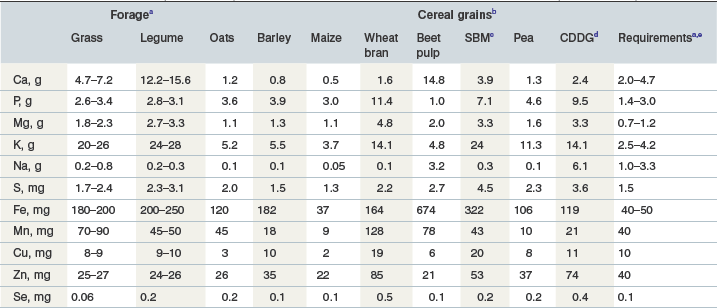
aNRC 2007; bSauvant et al 2004; cSBM = soybean meal; dCDDG = corn distillers dried grains.
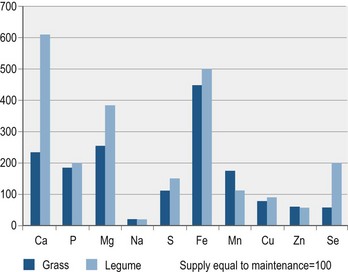
Figure 17.2 Supply of minerals from forage-only diets based on grass or legumes relative to the maintenance requirements (supply equal to maintenance = 100) of adult horses according to NRC (2007).
Fresh forage has a high content of β-carotene (vitamin A) and α-tocopherol (vitamin E), which should be sufficient to meet the requirements of all horses fed forage-only and high forage diets. However, during conserving and especially ensiling the content of both β-carotene and α-tocopherol may be reduced (Müller et al 2007), which can lead to marginal supply of vitamin E for horses fed non-vitamin supplemented diets.
Forage protein utilization
Gibbs et al (1988) reported high true digestibility values of forage protein in cannulated ponies over the total GI tract, but very low true ileal digestibility values (37%). However, nitrogen retention was high (42–59% of nitrogen digested) on all forage sources in the referred study. The ponies were fed at 2% of body weight with Coastal bermuda grass hay (11.7% CP in DM), low-protein alfalfa hay (15.0% CP in DM) and high-protein alfalfa hay (18.1% CP in DM). The low ileal digestibility values for forage protein in horses are in contrast to data on forage utilization in pigs showing high ileal digestibility values for both protein and amino acids (Phuc & Lindberg 2001, Reverter et al 1999) and high portal net appearance of amino acids (Reverter et al 2000). Therefore, since horses grow and develop satisfactorily on diets based entirely of forage (Duncan 1991), provided that energy and nutrient requirements are met (Forsmark 2006), it is difficult to accept that the true small intestinal digestibility should be as poor as indicated from the work by Gibbs et al (1988).
Impact of preservation
Historically, sun-drying in the field to produce hay was the predominant method for preservation of forage (Wilkins 1988). However, in many European countries with unstable weather conditions at harvest, barn-drying was introduced as a way of minimizing the risk for poor nutritional and hygienic quality of hay. Over the years, this has gradually been replaced by preservation by ensiling which is built on the principle of anaerobic fermentation (McDonald et al 1991). In the horse industry, use of silage with a high DM content (≥500 g DM), and called haylage, has become the common practice (Müller 2005). The extent of fermentation in the silage/haylage is influenced by the moisture content, resulting in less fermentation with increasing DM content. Thus, haylage will have a lower content of fermentation products (including lactic acid) and a higher pH compared to silage with a lower DM content (Müller 2005). The lower content of fermentation products in haylage may reduce the aerobic stability after opening of the bales. Moreover, the aerobic stability may be affected by the harvest date of the forage (Müller 2009). The common theory is that aerobic stability is shorter for stemmy material because of retention of air pockets in poorly compacted material. Moreover, a porous material may result in low haylage density and a greater gas exchange with the surrounding air. This will allow yeast growth, and if these are lactate-degrading yeast species the aerobic stability may be affected. In the referred study (Müller 2009), the aerobic stability was longer for haylage from herbage harvested in August than in haylage from herbage harvested in May and June. This was in contrast to the common theory that a late cut material, which is stemmy, is more difficult to compact and would contain more air pockets.
With an increased use of ensiled forage in horse feeding the impact of the ensiling process on the nutritional quality will become an issue. There are several indicators regularly used to evaluate silage quality in ruminant feeding (i.e., pH, organic acids, ammonia), which may also be useful in evaluating the nutritional properties of silage for horses (McDonald et al 1991, Müller 2005). Ammonia level in ensiled forage can be used as an indicator of silage quality and will also indicate if the protein fraction in the ensiled forage has been subjected to degradation during the ensiling process (McDonald et al 1991). High levels of ammonia may indicate a reduced protein quality (Table 17-3).
It has been shown that the palatability of forage may be affected by the method of preservation (Müller & Udén 2007). Horses fed the same grass crop preserved as hay (88% DM), silage (31% DM) or haylage (58% DM), had the highest rate of consumption and the longest eating time on silage followed in descending order by haylage and hay. The reason for these differences remains to be explained.
Horses, at maintenance, fed grass forage-only diets from the same crop, harvested at the same time and preserved as hay, silage (34% DM) or haylage (55% DM), did not show any differences in fermentation kinetics in the large colon (Müller et al 2008, Muhonen et al 2009). However, colonic lactobacilli counts increased on the silage diet and were greater than on the haylage diet, while colonic streptococci counts decreased on the haylage diet and were less than on the silage diet (Muhonen et al 2009). Perhaps most importantly, an abrupt change of the forage type (same crop) had only marginal effects on microbial composition of colonic contents (Muhonen et al 2009).
Impact of forage on performance
The nutritional quality of the forage will have a major impact on bodyweight gain and body development in young growing horses fed limited amounts of forage together with concentrate (Ott & Kivipelto 2002). Feeding forage high in both energy and protein will increase the chances of meeting the daily nutrient and energy needs of growing yearling horses. If, on the other hand, the forage is low in energy and protein and is given in limited amounts together with concentrate to growing yearling horses, there is a risk for poor bodyweight gain and body development (Ott & Asquith 1986).
It was recently shown that Standardbred trotters in race condition fed a high-quality forage-only diet could perform at a comparable level to those fed a typical forage : concentrate diet (Jansson & Lindberg 2008). This indicates that it should be possible to minimize the need for supplementing the performing horse with concentrate, provided that the nutritional quality of the forage is high. However, muscle glycogen content was approximately 13% lower before and after a standardized exercise test (treadmill) in horses fed the forage-only diet, while the extent of glycogen depletion was similar between diets. Moreover, while plasma glucose concentrations remained unaffected by diet composition, pre- and post-exercise plasma acetate concentrations were higher and insulin concentrations lower when Standard bred trotters in race condition were fed forage-only diets (Jansson & Lindberg 2012). These findings indicate a diet-induced shift in metabolism and substrate availability at a whole-body level that may affect performance. Interestingly, oral acetate supplementation of a hay : grain diet enhanced the rate of glycogen resynthesis during the early phase (0–4 h) of recovery after muscle glycogen depletion (Waller et al 2009). These data suggests that acetate, which is the major SCFA produced during hindgut fermentation of dietary fiber, may be an important substrate for energy metabolism in skeletal muscle.
Concentrate ingredients
Cereals
The content of carbohydrates, protein and fat varies considerably between cereal sources (Table 17-1). It is sometimes claimed that the country of origin has an impact on the nutritional properties of cereal grains (i.e., oats). However, differences in nutritional properties are related to variation in chemical composition which could be the result of variations in climate, agronomic factors and the variety used (Åman et al 1985, Pettersson & Åman 1987, Åman 1987, 1988). Thus, it appears likely that factors other than country of origin will be of importance for nutritional properties of cereal grains (Åman & Newman 1986).
The protein content is highest in wheat, followed in descending order by oats and barley, and with the lowest content in rice and maize. However, the protein quality is higher in oats, barley and rice (3.7–4.2% lysine of CP) than in wheat and maize (3.0–3.1% lysine of CP). In addition, the lysine content of oats is only affected to a minor extent with an increase in grain protein content, while the lysine content in barley and wheat decrease with an increase in grain protein content (Thomke 1970, Degussa 1996). For most horses (sedentary, pregnant, growing, or exercising) fed a mixed forage and straight cereal grains with barley, oats or rice as the cereal source, the supply of lysine should be sufficient to meet requirements (4.3% lysine of CP intake, NRC 2007). However, when wheat and maize are used as cereal sources in this type of diet there is a risk for marginal lysine supply. For lactating mares, a forage/cereal-based diet will not meet the lysine requirements (5.0–5.5% lysine of CP intake) and the diet must be supplemented with a protein source. In addition, there may be a risk for marginal supply of histidine for growing and exercising horses receiving unfortified forage/cereal diets (Table 17-4).
Table 17-4 Essential Amino Acid Profile (Relative to Lysine; Lysine = 100) in Selected Feedstuffs and in Horse Milk and Horse Muscle
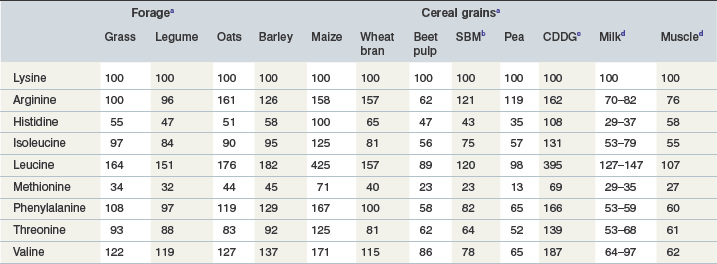
aSauvant et al 2004; bSBM = soybean meal; cCDDG = corn distillers dried grains; dbased on NRC 2007.
Oats and maize are relatively high in fat content (4–5.5%) and contain more than twice the amount present in wheat and rice (Table 17-1). This is also reflected in the content of individual postulated essential FA (linoleic and α-linolenic acid). All grain sources listed in Table 17-1, except rice, would meet the minimum linoleic acid requirement for horses (5 g/kg DM) suggested by the NRC (2007).
Based on existing data it can be estimated that in regular oats, fat provides approximately 14% of digestible energy (DE) content, a value which will be further increased up to approximately 18% in de-hulled and high fat oats (Lindberg et al 2006). In contrast, in other cereals commonly used in monogastric diets, fat provides around 3–5% of DE content.
Oats have the highest fiber content, followed in descending order by barley, wheat, maize and rice (Table 17-1). However, when oats are de-hulled there is a marked increase in the starch content and a marked decrease in the fiber content, resulting in a carbohydrate composition comparable to barley and wheat (Bach Knudsen 1997). De-hulling of oats will improve the digestibility of nutrients (Särkijärvi & Saastamoinen 2006) and will result in a higher energy value. Not only the fibre content, but also the fiber quality differs between cereals. For example, the fiber fraction in oats and barley is rich in β-glucans, while the fiber fraction in wheat, rye and triticale is rich in arabinoxylans (Bach Knudsen 1997). It is known that both soluble β-glucans and arabinoxylans have viscous properties, which may affect the gut environment and may therefore interfere with the digestive processes. In diets with high inclusion of oats and barley (high in soluble β-glucans), and in diets with high inclusion of wheat, rye and triticale (high in soluble arabinoxylans), this may be one of the factors that can contribute to disturbed gut function. This may be less of a problem in diets where the cereal sources are maize (corn) or rice, as they contain low levels of both soluble β-glucans and arabinoxylans.
As discussed in other chapters, high starch intake may result in a number of important equine diseases such as colic, gastric ulcers, tying-up and laminitis (Beyer 1998, Clarke et al 1990, Valberg 1998). It is generally accepted that certain forms of colic and laminitis are the result of changes in the microbial population and fermentation profile in the hindgut (Bailey et al 2004, Julliand et al 2008) which may be influenced by the amount of dietary starch.
Standardbred horses in training, fed a conventional forage : concentrate diet with a starch intake of 0.54 g/kg bodyweight (BW) per day, showed a reduced microbial stability and an increase in the fecal flora of lactic acid bacteria and members of the Streptococcus bovis/equis complex when compared to the feeding of a forage-only diet (Willing et al 2009). Therefore, there may be justification for a decrease in the previously suggested upper limit for starch intake (2 g starch/kg BW; Kienzle 1994, Potter et al 1992a) to avoid digestive problems in horses and support equine health and welfare, as discussed elsewhere.
The replacement of starch-rich cereal grains with non-starch based carbohydrate feeds (Lindberg 2005) and/or fat or oil (Potter et al 1992b) may be an alternative way of avoiding problems related to high starch intakes.
In forage-cereal diets, the dietary content of Fe, Mn and Cu may be too low when maize (corn) is used as the cereal source (Table 17-2). Moreover, cereal grains are low in Ca and high in P which will result in imbalanced Ca : P ratios in forage-cereal-based diets. This has to be corrected with Ca supplementation. If barley is used as the cereal source, the dietary content of Mn may not meet requirements, and the dietary content of Cu may be limiting with oat feeding.
